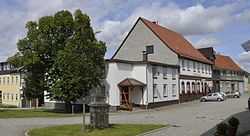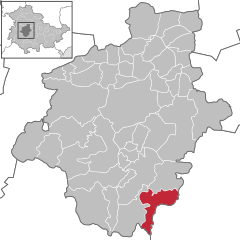Crawinkel
From Wikipedia, the free encyclopedia
| Crawinkel | ||
|---|---|---|
 | ||
| ||
 Crawinkel | ||
Location of Crawinkel within Gotha district 
 | ||
| Coordinates: 50°47′0″N 10°47′0″E / 50.78333°N 10.78333°ECoordinates: 50°47′0″N 10°47′0″E / 50.78333°N 10.78333°E | ||
| Country | Germany | |
| State | Thuringia | |
| District | Gotha | |
| Government | ||
| • Mayor | Stefan Schambach | |
| Area | ||
| • Total | 25.27 km2 (9.76 sq mi) | |
| Elevation | 469 m (1,539 ft) | |
| Population (2012-12-31)[1] | ||
| • Total | 1,480 | |
| • Density | 59/km2 (150/sq mi) | |
| Time zone | CET/CEST (UTC+1/+2) | |
| Postal codes | 99330 | |
| Dialling codes | 03624 | |
| Vehicle registration | GTH | |
| Website | www.crawinkel.de | |
Crawinkel is a municipality in the eastern part of Germany in the district of Gotha, Thuringia. Crawinkel was first mentioned in 1088.
After the Armistice with France in 1940, during World War II, German forces took numerous memorials from the forest of Compiègne, where the Armistice with Germany that ended World War I was also signed, as prizes to Crawinkel. These included the actual railway carriage where both armistices were concluded. In 1945, the car was dynamited and its pieces buried. Since the German reunification in 1989, numerous artifacts have been recovered and returned to France.
References
- ↑ "Bevölkerung der Gemeinden, erfüllenden Gemeinden und Verwaltungsgemeinschaften nach Geschlecht in Thüringen". Thüringer Landesamt für Statistik (in German). 13 July 2013.
| Wikimedia Commons has media related to Crawinkel. |
This article is issued from Wikipedia. The text is available under the Creative Commons Attribution/Share Alike; additional terms may apply for the media files.
